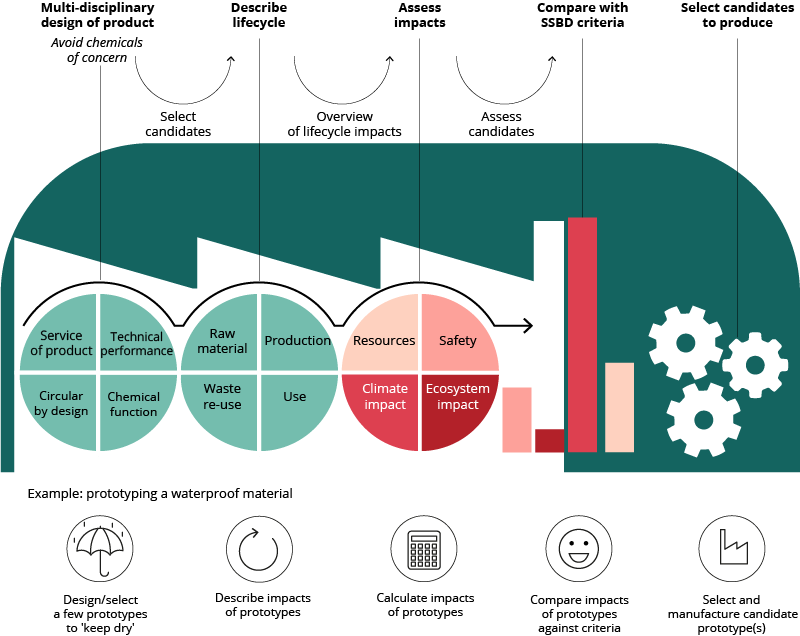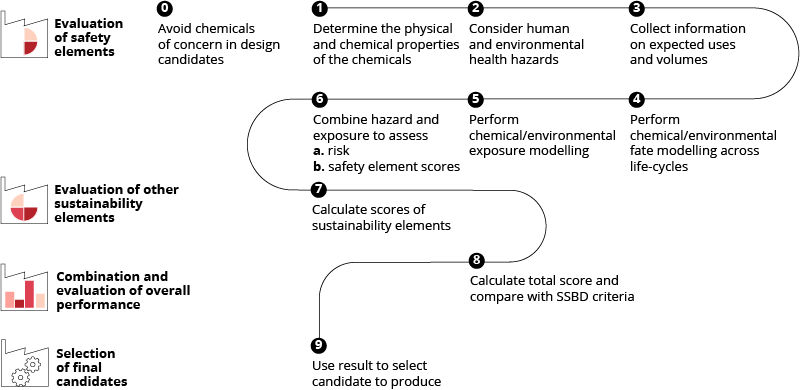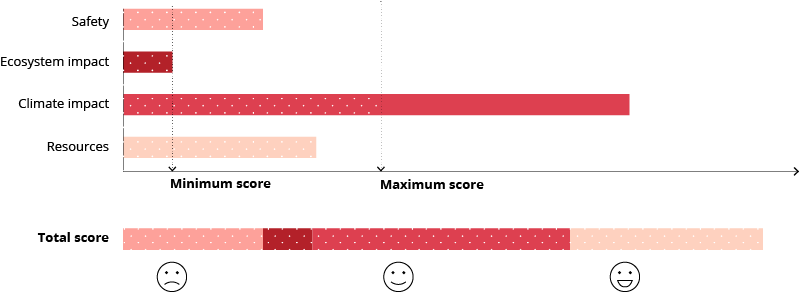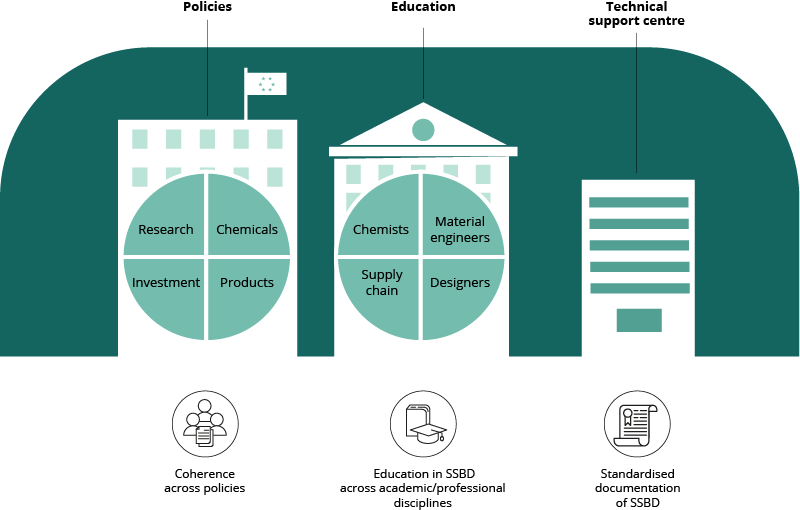Why should products be safe and sustainable by design?
Making products safe and sustainable by design has the potential to improve product safety, prevent pollution, mitigate climate change and enable a circular economy. This entails assessing product performance against requirements for safety and sustainability at the design stage of product development, rather than after a product has been designed and is on the market. During the design phase, product engineers have more flexibility to innovate to meet performance objectives for safety and sustainability. An upstream approach is more efficient and effective than having to address deficiencies at the end of the product development process.
Safe and sustainable by design is a pre-market design approach whereby the objectives of minimising the use of hazardous chemicals, reducing greenhouse gas emissions, and fostering the reuse and recycling of materials in a circular economy are built into product design.
The approach aims to ensure that a range of safety and sustainability requirements are met to minimum levels of performance throughout the product’s life cycle. Sustainability requirements can be derived from broader European policy objectives for sustainable development, such as the goals of the European Green Deal to:
- protect citizens against hazardous chemicals;
- transition to a carbon-neutral economy by 2050;
- deliver a circular economy; and
- protect nature and reverse the degradation of ecosystems.
Steps in the approach to safe and sustainable design
While the development of methodologies for delivering approaches to safe and sustainable design remain in the early phases, key steps in the product design process can be described (Figure 1).

Step 1. Identifying options for product delivery
As a first step, a multidisciplinary design team, comprising product designers, material engineers, chemists, toxicologists and sustainability experts, should consider the functionalities that a product delivers in terms of the service it provides to the customer. By focusing on the function that a product delivers rather than the form that it takes, the team can innovate more broadly and consider a wide range of possible candidates.
Defining a minimum level of performance can guide the selection of candidate products. Sustainability goals can also be built into the design up front. For example, product life cycles can be prolonged by increasing durability and reparability. Reducing the complexity of product design makes it easier to separate product components and either repair the product or recycle the individual components, reducing resource use and fostering circularity in the long term. The likely performance and risks of the various candidates against sustainability goals, including safety, greenhouse gas emissions and recyclability, is assessed in subsequent steps.
Step 2. Mapping the potential impacts of product options throughout the life cycle
A single product has an impact on the environment, climate and health throughout its life cycle, including raw material extraction, production, manufacturing, use, and disposal, reuse, or recycling. In gathering information to assess the performance of the candidate products against safety and sustainability goals, the full life cycle of each product should be mapped out and potential impacts on the various dimensions of safety and sustainability described:
- Chemical safety: estimate the diversity and volumes of chemicals used in production and in any recycling processes. Identify potential emissions throughout the life cycle and assess the impacts of possible exposures to hazardous chemicals on human health and ecosystems.
- Resource use and circularity: describe the resources consumed and the potential for end-of-life recovery for reuse and/or recycling.
- Greenhouse gas emissions: estimate energy consumption and the potential greenhouse gas emissions throughout the life cycle, considering the fuels used in production processes and waste management or recycling processes.
- Impacts on ecosystems: describe the range of potential environmental impacts, including ecosystem damage during resource extraction and emissions of pollution throughout the life cycle.
Step 3. Assess sustainability performance throughout the product’s life cycle
The next step is to assess performance of each candidate product against the various dimensions of safety and sustainability. A range of methodologies exist for assessing product performance against safety and sustainability goals. A useful example is the Product Environmental Footprint method, developed by the European Commission’s Joint Research Centre, which can be used to assess resource use and impacts on climate and ecosystems, as well as impacts on health from air pollution. Box 1 shows an example of how to assess the sustainability of chemicals used in products.
Further work is currently required to bring together the available methodologies into a coherent and consistent set of guidance on how to assess products against sustainability goals. In such assessments, the principal challenge is to gather sufficient information and robust data, which is followed by further work on gap-filling approaches and addressing uncertainties.
Box 1. Decision-making process for assessing the safety profile of a candidate product
The forthcoming guidance from the Organisation for Economic Co-operation and Development (OECD) on key considerations for identifying and selecting safer chemical alternatives can be used to structure an assessment of the safety profile of a product with regard to the chemicals used and emitted throughout the product’s life cycle (OECD, forthcoming). The guidance provides a decision-making process focusing on minimum assessment criteria and recommended assessment practices for substituting hazardous substances with less harmful substances. Under the process, the two dimensions of chemical risk — comparative hazard and exposure — are assessed and scored and the scores combined to give an overall score for safety. The guidance also includes recommendations for moving beyond the minimum chemical safety criteria and assessment practices.

Step 4. Selecting the most sustainable product option: scoring and minimum performance criteria
One approach to determining which candidate products are safe and sustainable by design is to score the performance of the candidates against each dimension of safety and sustainability. The scores are then summed to give a total score for each potential product. This then allows the various products to be ranked to inform a decision on which candidate to carry through to the product development phase.
Often some candidate products have a good performance on one dimension of safety or sustainability but a poor performance on another. For example, materials that make products more durable, and hence are beneficial from a resource perspective, may be problematic from a safety perspective if they incorporate hazardous chemicals. The use of fluoropolymers in consumer goods is an example of this.
To ensure that a candidate meets minimum performance requirements for all dimensions of safety and sustainability, minimum scores can be set for each dimension, as shown in Figure 3. For example, a candidate not meeting the minimum score for environmental impacts would be discarded. Minimum values could be linked to environmental legislation protection goals where possible, such as environmental quality standards for chemicals in local water bodies.
For simplicity, each dimension is equally weighted in Figure 3. However, weighting factors could be applied to the various dimensions of safety and sustainability.

Enabling the uptake of approaches to safe and sustainable design
A number of enabling conditions are required to support the development and uptake of approaches that are safe and sustainable by design across industrial sectors, as shown in Figure 4:
- Harmonised methodologies and minimum performance requirements against safety and sustainability goals to provide the basis for implementing consistent approaches across industrial sectors. The use of consistent approaches could be validated by independent bodies as a trustworthy confirmation of a product’s sustainability for the public.
- Educationand training on methodologies for safe and sustainable design and associated safety and sustainability requirements for key people in the design process, including product engineers, plant managers, chemists, sustainability experts and decision-makers throughout the product’s supply chain.
- Available finance for short- and long-term investments, such as earmarked funds to support small and medium-sized enterprises to implement safe and sustainable by design approaches. Another option is to include safe and sustainable design in the criteria for sustainable investments.
- Research and innovation to support the further development of methodologies to implement safe and sustainable by design approaches. Technology centres could be established to support small and medium-sized enterprises. Research policies also call for the innovation of non-toxic materials and products, as well as substitutes for hazardous chemicals currently in use.
- Coherent and ambitious chemicals legislation across the chemical, product and waste policy domains to provide certainty for industry and to encourage the substitution of hazardous chemicals and support for investment in safe and sustainable design-based production processes.

Challenges and opportunities
One key challenge is that current manufacturing systems are extensively interconnected, with many product value chains operating at the global level. Implementing change in one part of the system therefore has knock-on effects, and implementing safe and sustainable by design approaches requires effective collaboration throughout the product value chain, from production through to waste management, reuse and recycling.
Chemical production is especially highly interconnected, and changes in one process can jeopardise the production of feedstock for another. The infrastructure for extracting, producing and manufacturing raw materials is extremely costly, locking in polluting processes and creating barriers to technological change. The education sector is a further source of potential inertia, as students of engineering, product design and chemical synthesis typically have little or no training in how to incorporate safety and sustainability aspects into product design.
In terms of opportunities, the European Commission’s next research and innovation framework, Horizon Europe, is expected to support the development and uptake of approaches that are safe and sustainable by design. This may include developing and validating guidance materials, cross-disciplinary exchanges of good practice and establishing pilot projects in key industrial sectors. Training on approaches and methods for the upstream design of safe and sustainable products can be delivered through technical support centres. Such centres may also perform independent assessments and validate products as safe and sustainable. This will help foster innovation and guarantee the credibility and quality of safe and sustainable products made or imported for use in Europe.
Identifiers
Briefing no. 29/2020
Title: Designing safe and sustainable products requires a new approach for chemicals
HTML - TH-AM-20-029-EN-Q - ISBN 978-92-9480-349-8 - ISSN 2467-3196 - doi: 10.2800/055747
PDF - TH-AM-20-029-EN-N - ISBN 978-92-9480-348-1 - ISSN 2467-3196 - doi: 10.2800/48128




Document Actions
Share with others